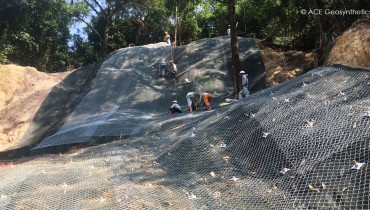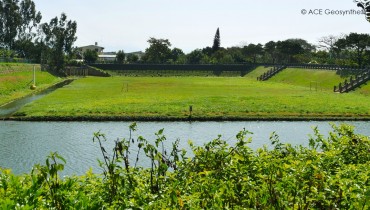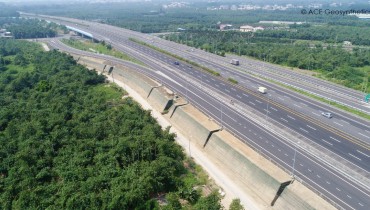News
Geosynthetic Reinforced Soil Embankment for Earthquake Rehabilitation on National Freeway No. 4 in Taiwan
"TOP STORY"

Located at the boundary of the Eurasian plate and the Philippine plate, Taiwan is home to 51 faults. The frequent occurrence of earthquakes along these faults poses a significant threat to lives and property. One notable example is the 1999 Chi-chi earthquake, caused by the Chelungpu fault in central Taiwan. This devastating earthquake resulted in approximately 14,000 casualties, numerous injuries, and the collapse of over 100,000 houses. The Chelungpu fault stretches from north to south along the eastern foothills of the Taichung Basin.
Background
The extension project of National Freeway No. 4 must meet the Chelungpu fault at stations 23k+242 to 23k+410. Once, the Chi-chi earthquake caused an 85-kilometer surface rupture, with vertical displacement of 4-5m and horizontal displacement of 2.5-5m. Therefore, the construction site experiences significant surface terrain changes and elevations ranging from 300 to 450 meters. The west slope is near Wuniulan Creek, while the east side has a steep slope with debris, limiting construction space. The embankment section's design elevation differs by up to 20 meters from the ground surface due to alignment requirements. Retaining structures are crucial for embankment safety. Site investigations revealed poor engineering properties in shallow geological formations of colluvium and gravel. The underlying bedrock consists of shale, sandy mudstone, and alternating layers of sandstone and shale with shear fractures associated with the Chelungpu fault, resulting in weak rock mass strength.

Figure 1. The intersection of the site and Chelungpu fault (Sinotech Engineering Consultants, Ltd., 2017)
Solution
The traditional geotechnical engineering solutions for fault areas include:
1. Rigid foundations or structures
2. Embedded retaining structures or buffer trenches
3. Placement of ductile engineering fills
Factors impacting the project's overall stability and safety include narrow site proximity, high embankment, significant differential deformation due to fault movement, and the need for prompt earthquake damage repair. Considering these site conditions and the design principle of earthquake damage control—no damage for a small earthquake, repairable for a medium earthquake, and no collapse for a strong earthquake—the designer opted for geosynthetic Geosynthetic reinforced soil structures (GRS) to construct a 168-meter-long embankment. The steep slope near Wuniulan Creek resolved the issue of limited space. Moreover, the GRS design allowed for the reuse of excavated material from the nearby Fengyuan No. 3 tunnel, reducing the transport of unwanted earth material and associated costs. This approach aligns with the project's focus on energy conservation, carbon reduction, and sustainable development.


Analysis and Design for GRS Embankment
1. Stability Analysis
The static stability analysis of the GRS embankment prioritizes external stability under various conditions, including normal, seismic, and storm events. Factors such as sliding, overturning, and bearing capacity are considered. The SLIDE 6.0 program is utilized for overall slope stability analysis using the limit equilibrium method. Internal stability analysis verifies geogrid pullout and tensile strength. Design schemes, embankment configurations, and effective embedded length and spacing of the geogrid are determined based on these analyses. Seismic coefficients for dynamic analysis follow the guidelines outlined in the "Code for Seismic Design of Freeway Bridges" issued by the MOTC (2018). Emergency backfill is also considered to address surface rupture caused by fault movement, with its weight factored into ensuring embankment safety.
|
Condition of Analysis |
Factor of Safety |
|
|
External |
Sliding |
1.21 |
|
Overturning |
3.71 |
|
|
Bearing Capacity |
1.82 |
|
|
Overall Stability |
1.42 |
|
|
Internal |
Tensile Strength |
1.84 (min.) |
|
Pullout Resistance |
59.8 (min.) |
|
Table 1. The results of stability analyses for GRS embankment under seismic condition.
2. GRS Design and Construction
Due to poor engineering properties, the GRS embankment requires enhanced bearing capacity. To achieve this, a GRS foundation is recommended, involving the removal of weak shallow colluvium and its replacement with a GRS foundation. Figure 2 depicts the placement of 150kN/m ACEGrid® geogrids in a crisscross pattern. Two layers of ACEGrid® are laid perpendicular to the freeway direction with a 0.6m vertical spacing, while an additional layer is placed parallel to the freeway direction with a 0.3m spacing. The backfill material for the GRS foundation is compacted to at least 95% of the modified Proctor maximum dry density. The replaced GRS foundation extends about 140m in length and reaches a depth of 3 to 5m, reaching the gravel stratum or bedrock with favorable engineering properties. The GRS embankment design has a slope aspect ratio of 1:0.2 (vertical:horizontal) due to space constraints. It is divided into three 5m-high stages with a step-back platform width of 1.5m. The geogrid configuration is carefully designed, with a vertical spacing of 0.3m for the lowest stage and 0.5m for the other two higher stages. The embedded lengths of the geogrids, from lower to upper layer, are 20m, 18.8m, and 17m, respectively.

Figure 2. The design scheme of the GRS embankment (Sinotech Engineering Consultants, Ltd., 2017)
To enhance drainage and safeguard against seepage and heavy rainfall, each stage of the GRS embankment features a 0.5m thick permeable material and HDPE drainage pipes at the base. ACESandbag™ geobags, containing seed, fertilizer, and organic soil, are integrated into the embankment using the geogrid wrapped-around method, promoting vegetation growth and enhancing its aesthetic appeal. Adjacent slope protection and the preservation of Wuniulan Creek's riverbank are achieved through a permanent pile-supported retaining structure. Close-spaced 1.5m diameter piles ensure stability, while the upper slope adopts a gentle 1:2.5 (vertical: horizontal) slope, covered by reinforced concrete lattice girders. Additional 40-ton preloaded anchors, positioned at 2.5m intervals in the X and Y directions, secure the embankment against various conditions, including rainstorms and earthquakes, meeting all safety requirements.


Conclusion
The safety of structures is greatly affected by fault movement. Despite technical limitations, the reported case necessitates passing through the Chelungpu active fault. After evaluating various countermeasures, the GRS embankment has emerged as the most suitable solution. Thorough safety considerations and analyses have been conducted, with the key points summarized below.
1. To improve bearing capacity and stability, the GRS embankment requires replacing weak subsoils with a GRS foundation. This solution also effectively restrains the displacement of the fault zone.
2. Static and dynamic analyses of the GRS embankment demonstrate its stability under various conditions, meeting all safety requirements. However, additional studies are recommended to investigate the detailed mechanisms of the GRS structure in relation to fault movement.
3. Various slope stabilization methods have been employed to ensure the safety of the adjacent slope for the GRS embankment. These treatments provide comprehensive protection for the targeted facility.
4. As the site is located near a tunnel construction, the design of the GRS embankment allows for the reuse of a substantial number of excavated materials from the tunnel. This approach reduces the cost associated with disposing of unwanted earth materials, aligning with the principles of energy conservation, carbon reduction, and sustainable development.
Similar News

Safeguarding for Shallow Slope Sliding: A Sustainable Slope Stabilization Project
TOP STORY Shallow Landslide Treatment Project, Ba Deo Park, Ha Long City, Vietnam Backgrou...

Innovative Flood Management: Detention Pond with Flood Control and Recreational Design
Detention Pond with Reinforced Earth Dike for Fazi River, Taichung, Taiwan Background In recen...

Reinforcement of the Slope at the Entrance Ramp of Interchange on National Freeway, Taiwan
"TOP STORY" In Taiwan, an island nation, freeways play a pivotal role in facilita...
